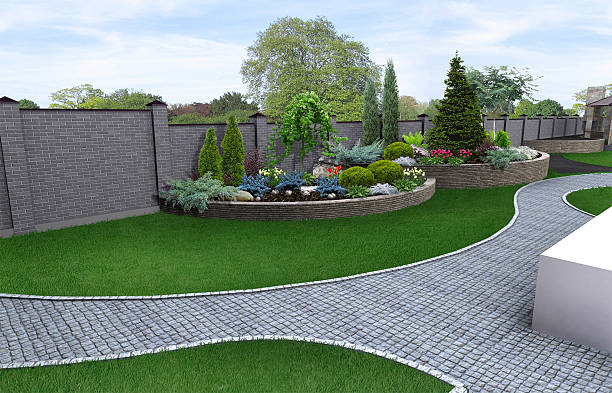Winterizing your lawn edging is a crucial step in maintaining the longevity and functionality of your outdoor space. This comprehensive guide aims to provide an objective and impersonal examination of the types of materials available for lawn edging, emphasizing their importance in winter preparation.
By eliminating personal pronouns, this article seeks to maintain a scholarly tone while exploring the necessary steps and valuable tips to protect lawn edging from freezing temperatures during winter months. Additionally, it will discuss proper maintenance and care for lawn edging throughout the cold season.
Key Takeaways
– Metal, plastic, stone, or brick edging materials can be used to protect your lawn during winter.
– Winterizing your lawn edging is important to maintain its functionality and appearance.
– Steps to prepare your lawn edging for winter include inspecting, cleaning, applying protective coating, and adding insulation.
– To protect lawn edging from freezing temperatures, create a barrier, cover with burlap or fabric, and secure it properly.
Types of Lawn Edging Materials to Consider
Various types of materials for grass edging can be considered when winterizing your lawn. These materials play a crucial role in defining the edges of your lawn and protecting it from harsh weather conditions during the winter months. One popular option is metal edging, which offers durability and strength, making it resistant to frost heave and snow accumulation. Another choice is plastic edging, which is lightweight and easy to install. It provides a flexible barrier that can withstand freezing temperatures without cracking or breaking. Additionally, there are also natural options such as stone or brick edging, which add an aesthetic appeal to your lawn while providing stability and protection against winter elements. Considering these various materials will ensure that your lawn remains protected throughout the winter season.
Transitioning into the subsequent section on the importance of winterizing your lawn edging, it becomes evident that selecting the right material plays a significant role in maintaining the integrity of your landscaping during harsh weather conditions.
Importance of Winterizing Your Lawn Edging
The preservation of lawn edging during the winter season is of significant importance. Winter weather conditions, such as freezing temperatures, snow accumulation, and ice formation, can cause damage to unprotected lawn edging. This damage not only affects the aesthetic appeal of the landscape but also compromises the functionality and durability of the edging material. Without proper winterization measures, lawn edging may become dislodged, cracked, or even completely destroyed. Additionally, neglected or damaged lawn edging can lead to issues such as soil erosion and weed growth. Therefore, it is crucial to take necessary steps to prepare your lawn edging for winter in order to ensure its longevity and effectiveness in defining borders and maintaining a neat appearance throughout the year.
Steps to Prepare Your Lawn Edging for Winter
To prepare lawn edging for winter, it is essential to follow a set of recommended steps that will help protect the edging material from potential damage caused by freezing temperatures, snow accumulation, and ice formation. These steps involve inspecting the edging for any signs of wear or damage, cleaning and removing debris from the area surrounding the edging, applying a protective coating or sealant to prevent moisture infiltration, and adding an insulating layer such as mulch or straw around the edging. By taking these precautions, homeowners can ensure that their lawn edging remains intact and functional throughout the winter season.
| Steps to Prepare Lawn Edging for Winter |
| 1. Inspect for wear or damage |
| 2. Clean and remove debris |
| 3. Apply protective coating |
| 4. Add insulating layer |
Transition: Implementing these steps will significantly reduce the risk of damage to your lawn edging during freezing temperatures. Next, we will discuss some additional tips for protecting your lawn edging from extreme cold weather conditions without using ‘step’.
Tips for Protecting Lawn Edging From Freezing Temperatures
One effective method of protecting lawn edging from freezing temperatures is to create a barrier between the edging material and the cold weather conditions. This can be achieved by using insulating materials such as mulch or straw around the edging. These materials act as a protective layer, preventing direct contact between the edging and the freezing temperatures. Additionally, covering the entire length of the lawn edging with burlap or landscape fabric can provide an extra layer of insulation. It is important to ensure that the barrier is securely in place to prevent it from being blown away by strong winds. By implementing these measures, lawn owners can effectively shield their edging from extreme cold temperatures during winter.
Transitioning into the subsequent section about maintenance and care for lawn edging during winter, it is crucial to regularly inspect the barriers and make any necessary repairs or adjustments to maintain their effectiveness throughout the season.
Maintenance and Care for Lawn Edging During Winter
Regular inspection and necessary repairs or adjustments to the barriers are crucial for maintaining their effectiveness in protecting lawn edging during winter. Neglecting maintenance can lead to damage, compromising the overall functionality of the lawn edging. To ensure proper care, consider the following:
- Clean debris: Remove any leaves, branches, or other debris that may accumulate near the edges of the lawn. This will prevent water from pooling and potentially freezing, which could cause damage.
- Check for cracks: Inspect the barriers for any cracks or gaps that may have developed over time. These openings can allow moisture to seep in and freeze, leading to expansion and potential breakage.
- Secure loose barriers: If any sections of the lawn edging have become loose or unstable, secure them back into place using appropriate fasteners or adhesives. This will help maintain a uniform barrier throughout winter.
Conclusion
In conclusion, the winterizing process for your lawn edging is of utmost importance to ensure its longevity and functionality. By considering various materials and taking necessary steps such as cleaning, repairing, and insulating, you can protect your edging from freezing temperatures and harsh conditions. Remember to always prioritize maintenance and care during the winter months. Because who doesn’t enjoy spending their time in freezing weather tending to their beloved lawn edging? Surely, it’s a task we all eagerly await with bated breath.




















